Pathway Simulation and Evaluation of Carbon Neutrality in the Sichuan-Chongqing Region Based on the LEAP Model
Abstract
1. Introduction
2. Research Approach and Regional Data Sources
3. Current Carbon Emission Analysis and Model Construction
3.1. Analysis of Energy Consumption and Carbon Emissions in the Sichuan-Chongqing Region over the Years
3.2. LEAP Model Construction and Scenario Analysis
- (1)
- Selection of Baseline Year Parameters
- (2)
- Carbon Neutrality Scenario Construction for the Sichuan-Chongqing Region
- (3)
- Relationship Between Economic Development and Energy Consumption in the Sichuan-Chongqing Region
4. Result Analysis
4.1. Overall Trends of Energy Consumption and Carbon Emissions in the Sichuan-Chongqing Region
4.2. Trends in Changes in Energy Demand
4.3. Energy Demand and Carbon Emission Characteristics by Sector
4.4. Analysis of Carbon Peaking and Emission Trends Under Different Scenarios
5. Conclusions
Author Contributions
Funding
Institutional Review Board Statement
Informed Consent Statement
Data Availability Statement
Conflicts of Interest
References
- Zhang, Z.; Hu, G.; Mu, X.; Kong, L. From low carbon to carbon neutrality: A bibliometric analysis of the status, evolution and development trend. J. Environ. Manag. 2022, 322, 116087. [Google Scholar] [CrossRef]
- Raza, S.; Ghasali, E.; Raza, M.; Chen, C.; Li, B.; Orooji, Y.; Lin, H.; Karaman, C.; Maleh, H.K.; Erk, N. Advances in technology and utilization of natural resources for achieving carbon neutrality and a sustainable solution to neutral environment. Environ. Res. 2023, 220, 115135. [Google Scholar] [CrossRef]
- Li, R.; Liu, Q.; Cai, W.; Liu, Y.; Yu, Y.; Zhang, Y. Echelon peaking path of China’s provincial building carbon emissions: Considering peak and time constraints. Energy 2023, 271, 127003. [Google Scholar] [CrossRef]
- Xin, L.Y. Sichuan Has the Largest Installed Hydropower Capacity in China at 89.04 Million Kilowatts. Sichuan Daily, 20 December 2021; p. 001. [Google Scholar]
- Liang, H.M.; Wen, L.P. Discussion on the interconnection benefits of the Northwest Power Grid and the Sichuan-Chongqing Power Grid. Northwest Electr. Power Technol. 2001, 4–9+2. [Google Scholar]
- Fang, H.; Li, H. Analysis of Influencing Factors and Prediction of the Peak Value of Industrial Carbon Emission in the Sichuan-Chongqing Region. Sustainability 2024, 16, 4532. [Google Scholar] [CrossRef]
- Slamersak, A.; Kallis, G.; O’Neill, D.W. Energy requirements and carbon emissions for a low-carbon energy transition. Nat. Commun. 2022, 13, 15. [Google Scholar] [CrossRef]
- Liu, P.; Wu, J. Study on the diffusion of CCUS technology under carbon trading mechanism: Based on the perspective of tripartite evolutionary game among thermal power enterprises, government and public. J. Clean. Prod. 2024, 438, 140730. [Google Scholar]
- Liu, H.J.; Were, P.; Li, Q.; Gou, Y.; Hou, Z. Worldwide Status of CCUS Technologies and Their Development and Challenges in China. Geofluids 2017, 2017, 6126505. [Google Scholar]
- Ren, Z.; Zhang, S.; Liu, H.; Huang, R.; Wang, H.; Pu, L. The feasibility and policy engagements in achieving net zero emission in China’s power sector by 2050: A LEAP-REP model analysis. Energy Convers. Manag. 2024, 304, 118230. [Google Scholar]
- Han, J.; Li, J.; Tang, X.; Wang, L.; Yang, X.; Ge, Z.; Yuan, F. Coal-fired power plant CCUS project comprehensive benefit evaluation and forecasting model study. J. Clean. Prod. 2023, 385, 135657. [Google Scholar] [CrossRef]
- Zhao, K.K.; Cui, X.Z.; Zhou, Z.H.; Huang, P.X. Impact of uncertainty on regional carbon peak paths: An analysis based on carbon emissions accounting, modeling, and driving factors. Environ. Sci. Pollut. Res. 2022, 29, 17544–17560. [Google Scholar] [CrossRef]
- Zhang, Y.; Kong, Y.; Quan, J.; Wang, Q.; Zhang, Y.; Zhang, Y. Scenario analysis of energy consumption and related emissions in the transportation industry-a case study of Shaanxi Province. Environ. Sci. Pollut. Res. Int. 2024, 31, 26052–26075. [Google Scholar] [PubMed]
- Li, B.; Zhou, W.; Xian, Y.; Guan, X. Forecasting the energy demand and CO2 emissions of industrial sectors in China’s Beijing-Tianjin-Hebei region under energy transition. Environ. Sci. Pollut. Res. 2024, 31, 7283–7297. [Google Scholar] [CrossRef]
- Zhang, C.; Luo, H. Research on carbon emission peak prediction and path of China’s public buildings: Scenario analysis based on LEAP model. Energy Build. 2023, 289, 113053. [Google Scholar]
- Lili, S.; Huijuan, C.; Quansheng, G. Will China achieve its 2060 carbon neutral commitment from the provincial perspective? Adv. Clim. Change Res. 2022, 13, 169–178. [Google Scholar]
- Elzen, M.d.; Fekete, H.; Höhne, N.; Admiraal, A.; Forsell, N.; Hof, A.F.; Olivier, J.G.J.; Roelfsema, M.; Soest, H.v. Greenhouse gas emissions from current and enhanced policies of China until 2030: Can emissions peak before 2030? Energy Policy 2016, 89, 224–236. [Google Scholar]
- Zou, Z.; Ahmad, M. Economic digitalization and energy transition for green industrial development pathways. Ecol. Inform. 2023, 78, 102323. [Google Scholar] [CrossRef]
- Bai, Y.; Huang, Y.; Jiang, M.; Zhao, P.; Qi, Q.; Wang, Q. Spillover effects of structure-adjustment pollution reduction measures in China’s iron and steel industry. J. Environ. Manag. 2024, 368, 122133. [Google Scholar] [CrossRef]
- Huang, Y.; Wang, Y.; Peng, J.; Li, F.; Zhu, L.; Zhao, H.; Shi, R. Can China achieve its 2030 and 2060 CO2 commitments? Scenario analysis based on the integration of LEAP model with LMDI decomposition. Sci. Total Environ. 2023, 888, 164151. [Google Scholar]
- Liang, X.; Fan, M.; Huang, X.; Cai, C.; Zhou, L.; Wang, Y. Spatial distributed characteristics of carbon dioxide emissions based on fossil energy consumption and their driving factors at provincial scale in China. Energy 2024, 309, 133062. [Google Scholar]
- Wang, T.; Lun, X.X. [Construction Path of “Zero Carbon” Power Plant Based on the LEAP Model]. Huan Jing Ke Xue = Huanjing Kexue 2024, 45, 5632–5640. [Google Scholar] [PubMed]
- Ji, J.; Cao, L.; Bi, Y.; Zeng, Y.; Wang, D. Low-Carbon Transformation in Megacities: Benefits for Climate Change Mitigation and Socioeconomic Development—A Case Study of Shenzhen, China. Sustainability 2024, 16, 6062. [Google Scholar] [CrossRef]
- Li, S.; Kong, W.; Wang, Y.; Yuan, L. Medium and long-term energy demand forecasts by sectors in China under the goal of “carbon peaking & carbon neutrality”: Based on the LEAP-China model. Energy 2024, 310, 133017. [Google Scholar]
- Golfam, P.; Ashofteh, P.-S. Environmental-economic analysis of regional energy system under different supply and demand side scenarios with LEAP model. Environ. Dev. Sustain. 2024, 1–22. [Google Scholar] [CrossRef]
- Wan, F.; Li, J. Exploring hydrogen metallurgy to CO2 emissions reduction in China’s iron and steel production: An analysis based on the life cycle CO2 emissions—LEAP model. Energy Rep. 2024, 11, 4552–4563. [Google Scholar] [CrossRef]
- Hanson, E.; Nwakile, C.; Hammed, V.O. Carbon capture, utilization, and storage (CCUS) technologies: Evaluating the effectiveness of advanced CCUS solutions for reducing CO2 emissions. Results Surf. Interfaces 2025, 18, 100381. [Google Scholar] [CrossRef]
- Ping, W.X.; Wei, D.; Gu, L.S.; Liang, Z.J.; Lan, K.W. Spatial Correlation Network and Influencing Factors of Interprovincial Carbon Peak and Carbon Neutrality Capacity in China. Environ. Sci. 2025, 1–18. [Google Scholar] [CrossRef]
- Xing, Z.W.; Ming, C.J.; Meng, L.Y.; Dan, H.Y.; Feng, J.H. Global regional carbon neutrality estimation under different emission reduction policies based on the RICE model. Clim. Environ. Res. 2024, 29, 329–338. [Google Scholar]
- Zeng, J. (Ed.) Sichuan Statistical Yearbook 2023; China Statistics Press: Beijing, China, 2024; pp. 4–5. ISBN 978-7-5230-0162-2. [Google Scholar]
- Yang, H.; Li, T. (Eds.) Chongqing Statistical Yearbook 2023; China Statistics Press: Beijing, China, 2024; p. 5. ISBN 978-7-5230-0161-5. [Google Scholar]
- Guan, D.B.; Zhu, L.; Li, S.Y. Carbon Emission Accounts and Datasets. Available online: https://www.ceads.net/ (accessed on 14 September 2024).
- People’s Government of Sichuan Province. Sichuan Province “14th Five-Year Plan” for Energy Development. Available online: https://www.scgw.gov.cn/UploadFile/ArticFile/2022/3/21/bb8b27f5-7ca9-4954-8657-333367f7cd60.pdf (accessed on 15 October 2024).
- Chongqing Municipal People’s Government. Interpretation of the “14th Five-Year Plan” for Energy Development in Chongqing (2021–2025). Available online: https://www.cq.gov.cn/zwgk/zfxxgkml/zcjd_120614/bmjd/202206/t20220627_10859804.html (accessed on 14 October 2024).
- State Council of the People’s Republic of China. Carbon Peaking Action Plan Before 2030. Available online: https://files.in5.cn/guifan/202110/202110-2030%E5%B9%B4%E5%89%8D%E7%A2%B3%E8%BE%BE%E5%B3%B0%E8%A1%8C%E5%8A%A8%E6%96%B9%E6%A1%88.pdf (accessed on 12 October 2024).
- Cai, Z.; Li, Q.; Dai, S. Discussion on key technologies and model for hydropower-dominated electricity spot market in sichuan. In Proceedings of the 2021 China International Conference on Electricity Distribution (CICED), Shanghai, China, 7–9 April 2021; pp. 1074–1078. [Google Scholar]
- Energy; New Findings from Sichuan University in the Area of Energy Reported (Optimal Sizing of Hydro-PV-Pumped Storage Integrated Generation System Considering Uncertainty of PV, Load and Price). Energy Weekly News 2019. Available online: https://www.mdpi.com/1996-1073/12/15/3001 (accessed on 14 October 2024).
- Qi, Y.; Yu, G. Selection and Optimization of China’s Energy Transformation Pathway Under Carbon-Neutral Targets. Processes 2024, 12, 1758. [Google Scholar] [CrossRef]
- Rui, L.L.; Ming, H.Z.; Jie, W.Y.; Bo, Z.Y. Research on marketing strategies for “coal-to-gas” transition in the Sichuan-Chongqing region. Nat. Gas Technol. Econ. 2017, 11, 62–64+83–84. [Google Scholar]
- Perissi, I.; Martelloni, G.; Bardi, U.; Natalini, D.; Jones, A.; Nikolaev, A.; Eggler, L.; Baumann, M.; Samsó, R.; Solé, J. Cross-validation of the MEDEAS energy-economy-environment model with the integrated MARKAL-EFOM system (TIMES) and the long-range energy alternatives planning system (LEAP). Sustainability 2021, 13, 1967. [Google Scholar] [CrossRef]
- Liu, A.; Ye, L. (Eds.) China Statistical Yearbook 2024; China Statistics Press: Beijing, China, 2024; pp. 4–5. ISBN 978-7-5230-0486-9. [Google Scholar]
- Qi, Y.; Liu, H.; Zhao, J.; Zhang, S.; Zhang, X.; Zhang, W.; Wang, Y.; Xu, J.; Li, J.; Ding, Y. Trends and driving forces of agricultural carbon emissions: A case study of Anhui, China. PLoS ONE 2024, 19, e0292523. [Google Scholar] [CrossRef]
- Yi, L.X.; Wei, Y.Z.; Xue, L.L. Research on the evolution path of urban electricity consumption driven by terminal electrification. Proc. CSU-EPSA 2025, 1–11. [Google Scholar] [CrossRef]
- Armin, A.; Shiva, G.; Ahmad, B. Development and performance evaluation of a photovoltaic-powered induction cooker (PV-IC): An approach for promoting clean production in rural areas. Clean. Eng. Technol. 2022, 6, 100373. [Google Scholar]
- Yang, T.; Shu, Y.; Zhang, S.; Wang, H.; Zhu, J.; Wang, F. Impacts of end-use electrification on air quality and CO2 emissions in China’s northern cities in 2030. Energy 2023, 278, 127899. [Google Scholar]
- State Council of the People’s Republic of China. The 14th Five-Year Plan for National Economic and Social Development and the Vision for 2035 of the People’s Republic of China. Available online: https://www.gov.cn/xinwen/2021-03/13/content_5592681.htm (accessed on 27 October 2024).
- State Council of the People’s Republic of China. Sichuan Province’s “14th Five-Year Plan” Industrial Green Development Plan. Available online: https://www.dazhou.gov.cn/uploadfile/1/Attachment/7e01ad8483.pdf (accessed on 4 November 2024).
- Huo, T.; Xu, L.; Feng, W.; Cai, W.; Liu, B. Dynamic scenario simulations of carbon emission peak in China’s city-scale urban residential building sector through 2050. Energy Policy 2021, 159, 112612. [Google Scholar] [CrossRef]
- Dai, Y.; Zhu, Y.; Bai, Q. China’s Path to Low-Carbon Development by 2050: Scenario Analysis of Energy Demand and Carbon Emissions. Econ. Res. Ref. 2010, 2–22+33. [Google Scholar] [CrossRef]
- Meng, L.; Li, M.; Asuka, J. A scenario analysis of the energy transition in Japan’s road transportation sector based on the LEAP model. Environ. Res. Lett. 2024, 19, 044059. [Google Scholar] [CrossRef]
- Xu, M.; Liao, C.; Huang, Y.; Gao, X.; Dong, G.; Liu, Z. LEAP model-based analysis to low-carbon transformation path in the power sector: A case study of Guangdong-Hong Kong-Macao Greater Bay Area. Sci. Rep. 2024, 14, 7405. [Google Scholar] [CrossRef]
- People’s Government of Sichuan Province. Sichuan Province “14th Five-Year Plan” for Comprehensive Transportation Development. Available online: https://www.gyct.gov.cn/UploadFile/SiteFile/20160627193049219/2021/11/02/0fc2748ad3d44bc69cdebe2849c18121.pdf (accessed on 15 October 2024).
- People’s Government of Sichuan Province. Carbon Peaking Implementation Plan for Sichuan Province. Available online: https://www.eesia.cn/upload/files/2023/1/755debaf57d0675b.pdf (accessed on 16 October 2024).
- Ren, Z.; Zhou, B.; Ning, L.; Zheng, W.; Liu, H.; Hu, D.; Sun, J. Optimal dispatch of industrial loads considering process constraints for renewable energy consumption. Int. J. Electr. Power Energy Syst. 2025, 166, 110550. [Google Scholar]
- Zhong, F.; Yin, Y.; Tian, J.; Jiang, D.; Mao, Y. Carbon Reduction Pathways for Chinese Provinces: Considering Carbon Intensity Convergence, Regional Development Plans, and Shared Socioeconomic Pathways. Atmosphere 2024, 15, 918. [Google Scholar] [CrossRef]
- Qiu, L.; Niu, K.; He, W.; Hu, Y. Two Contribution Paths of Carbon Neutrality: Terrestrial Ecosystem Carbon Sinks and Anthropogenic Carbon Emission Reduction-A Case of Chongqing, China. Sustainability 2023, 15, 11306. [Google Scholar] [CrossRef]
- Fan, Y.; Xiu, Y. Construction of an Urban Carbon Neutrality Pathway Research Method Based on an Accounting Model: A Case Study of Chengdu. Urban Dev. Stud. 2023, 30, 113–123. [Google Scholar]
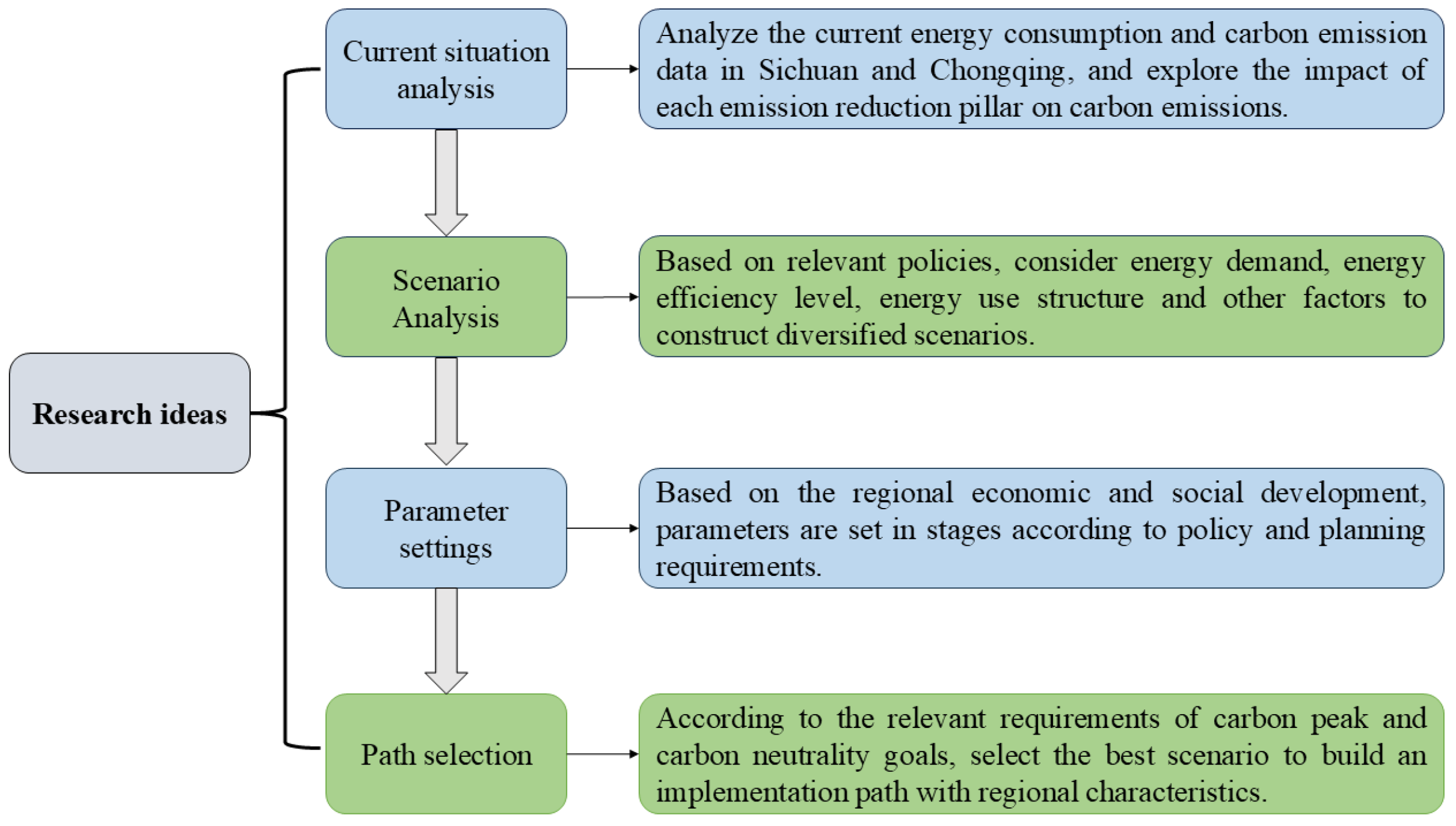
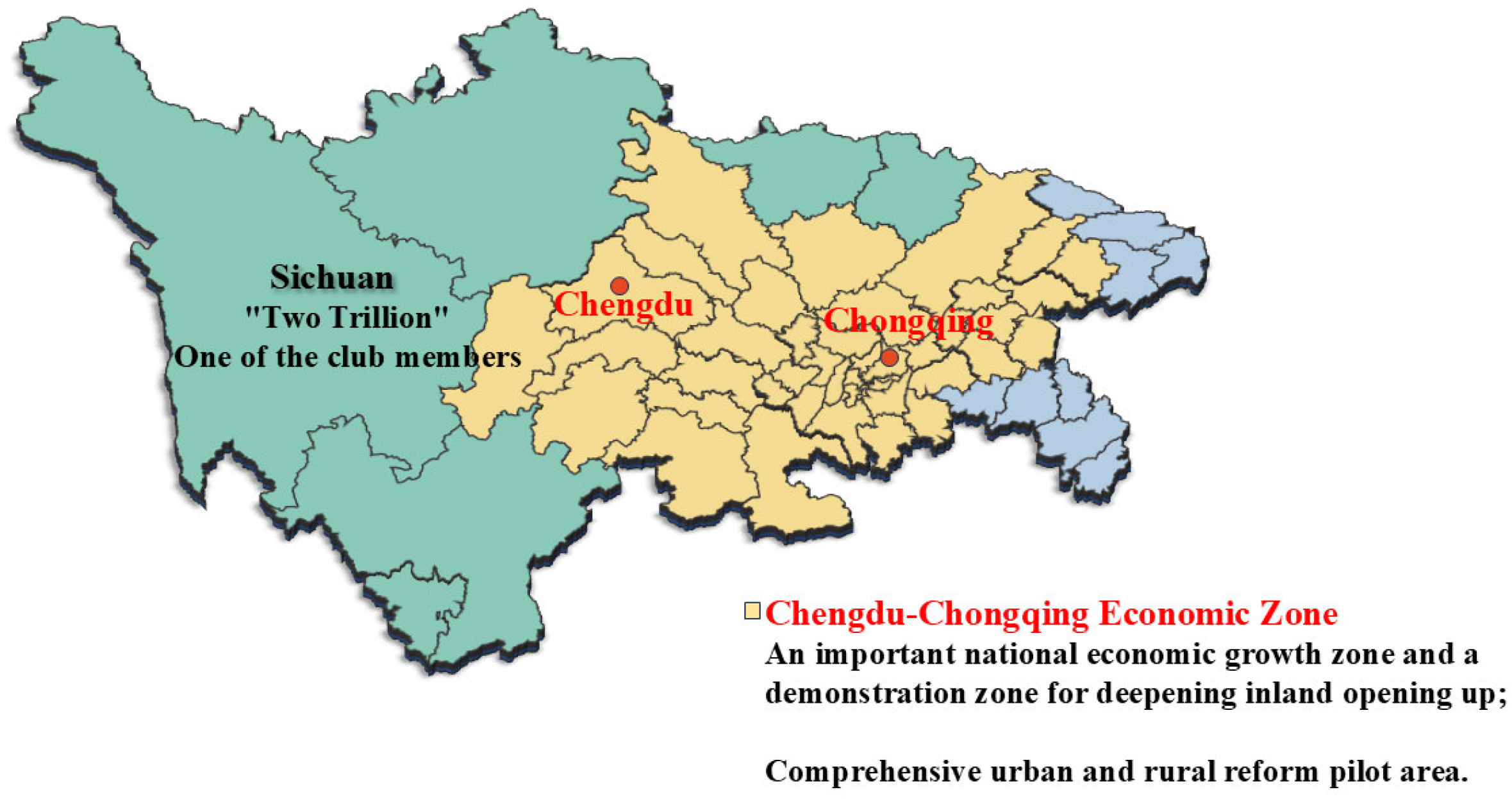
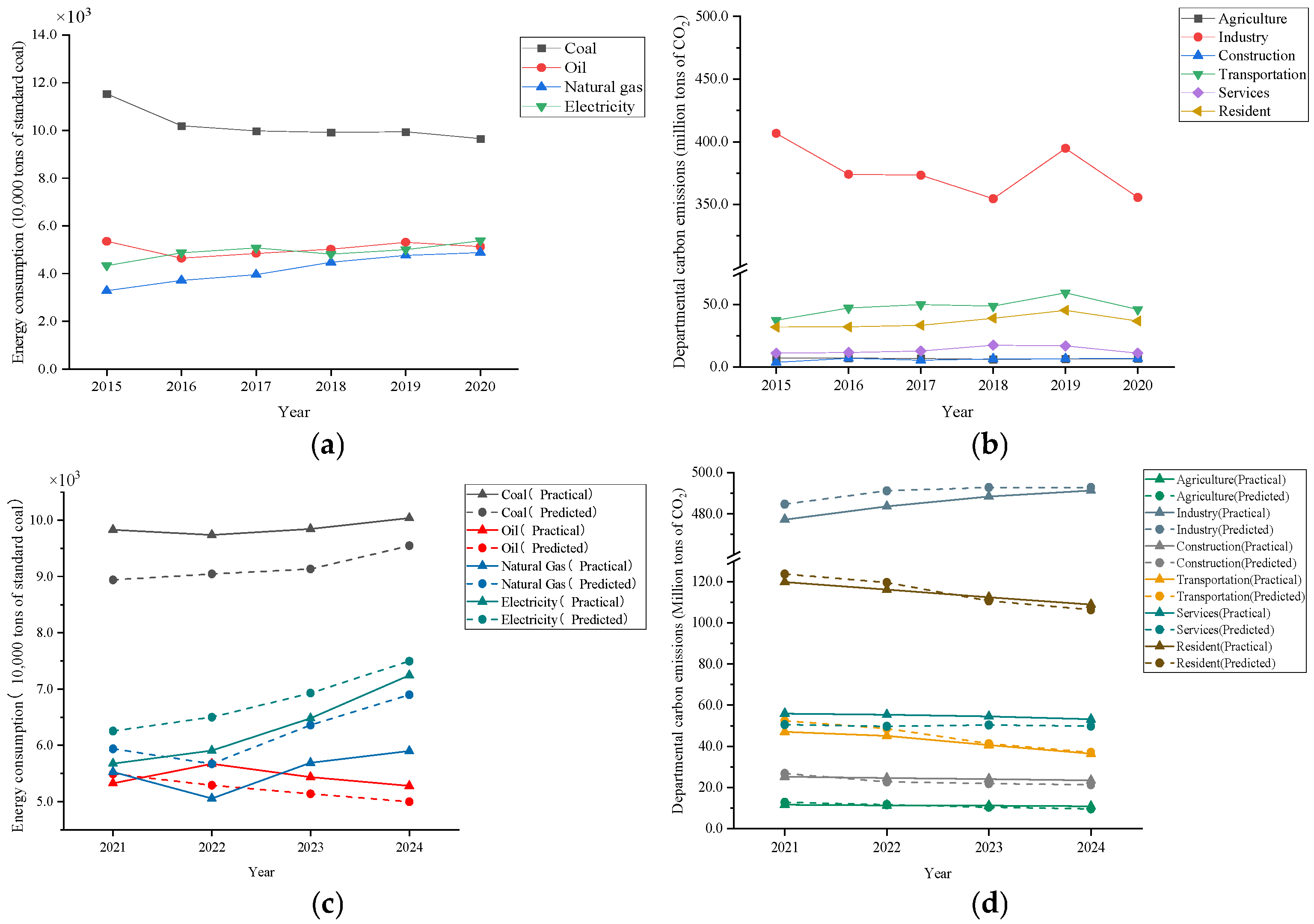
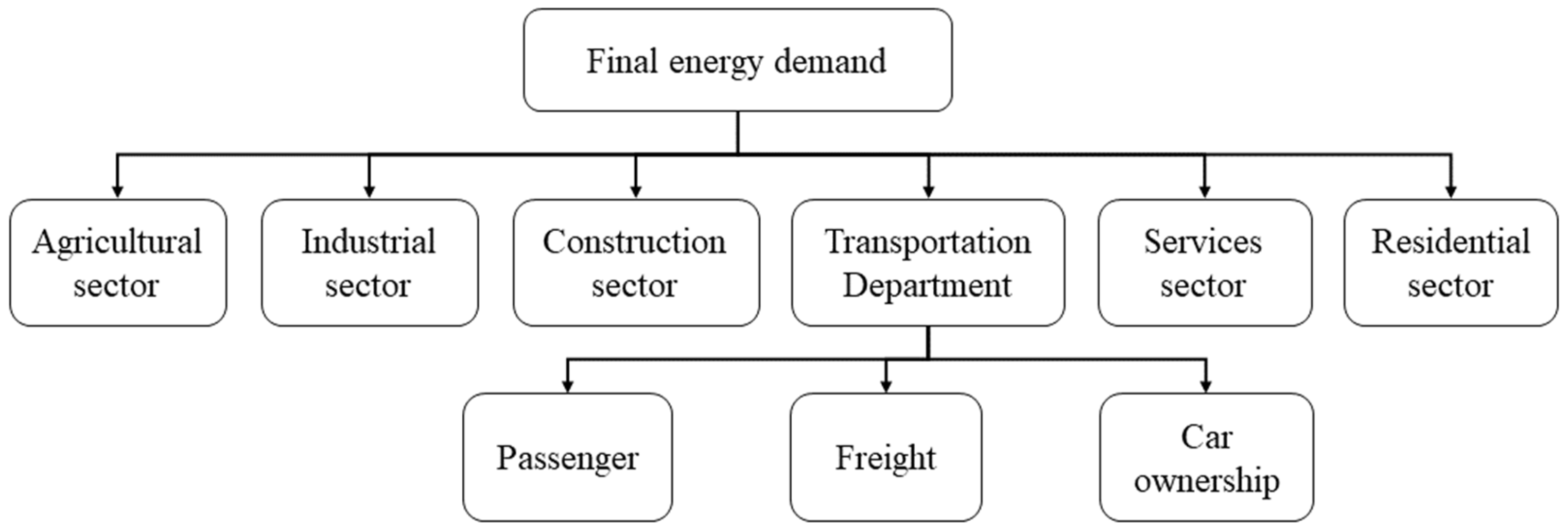
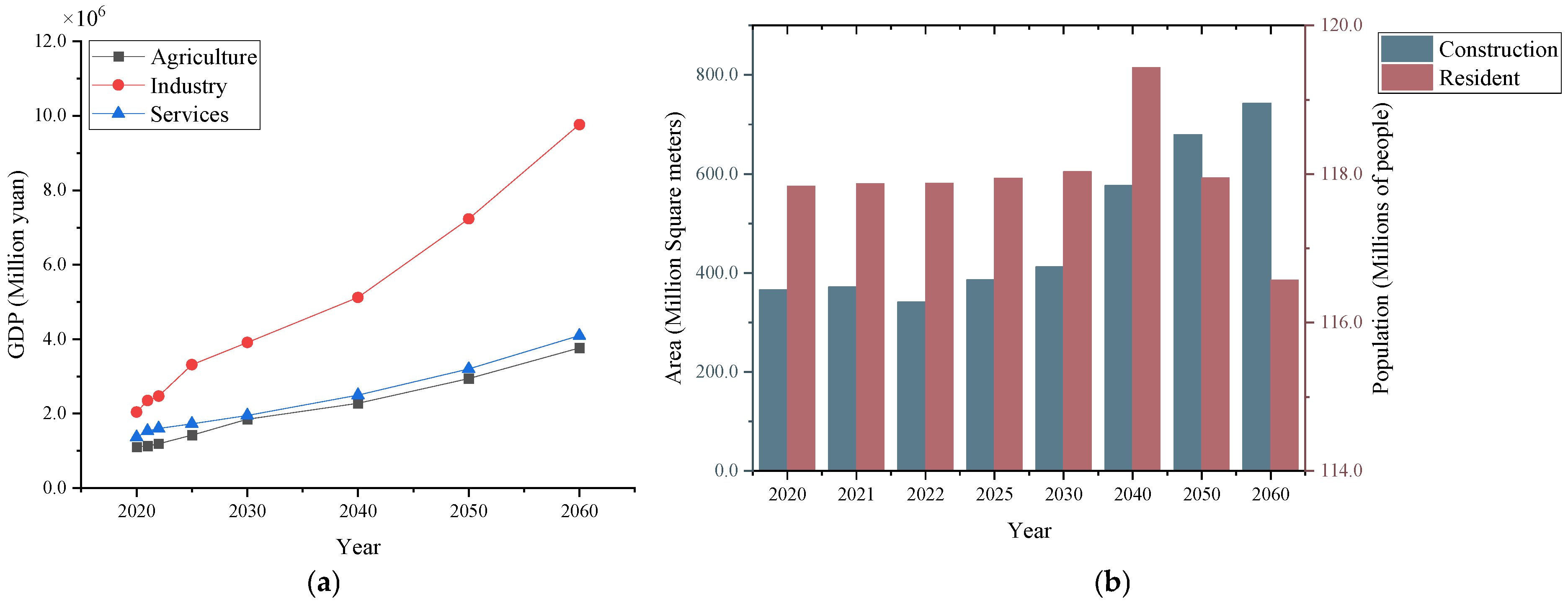
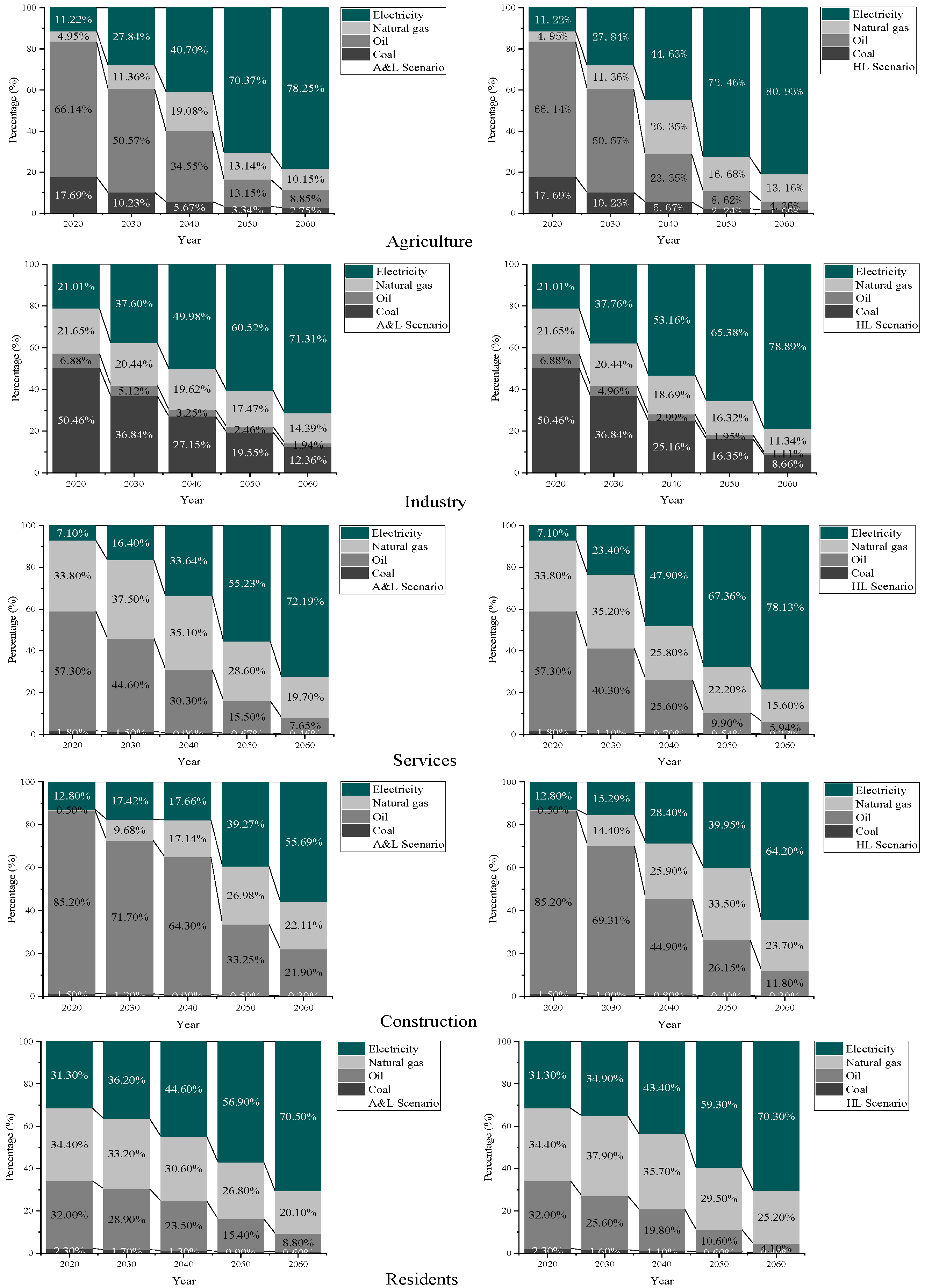
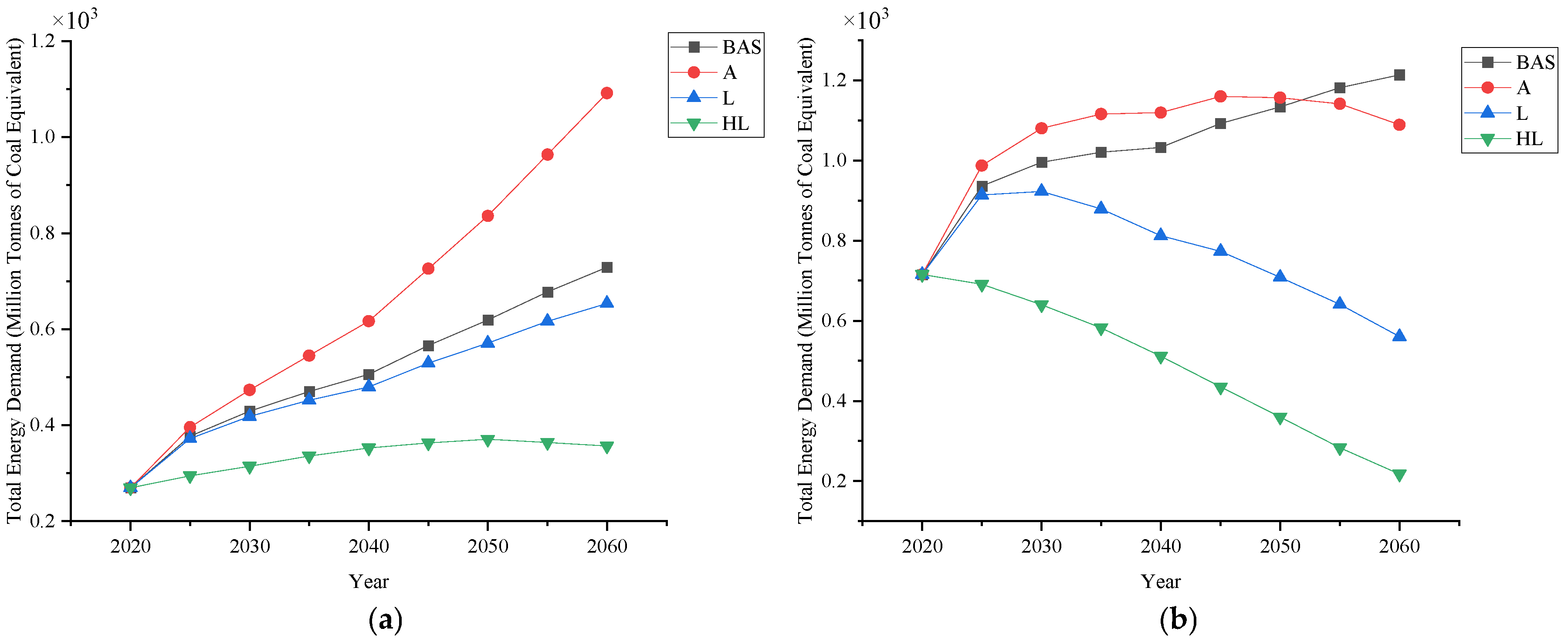
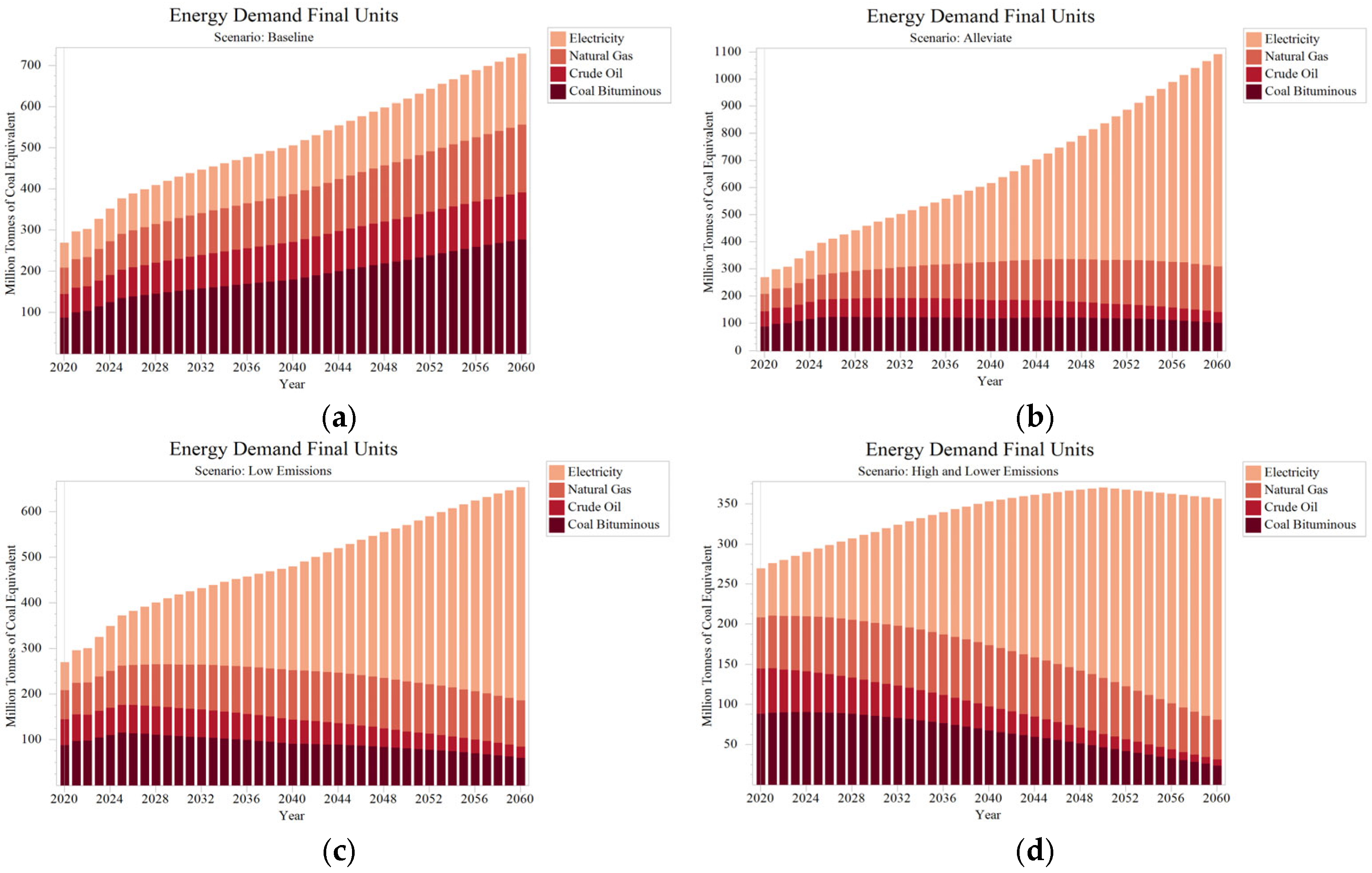
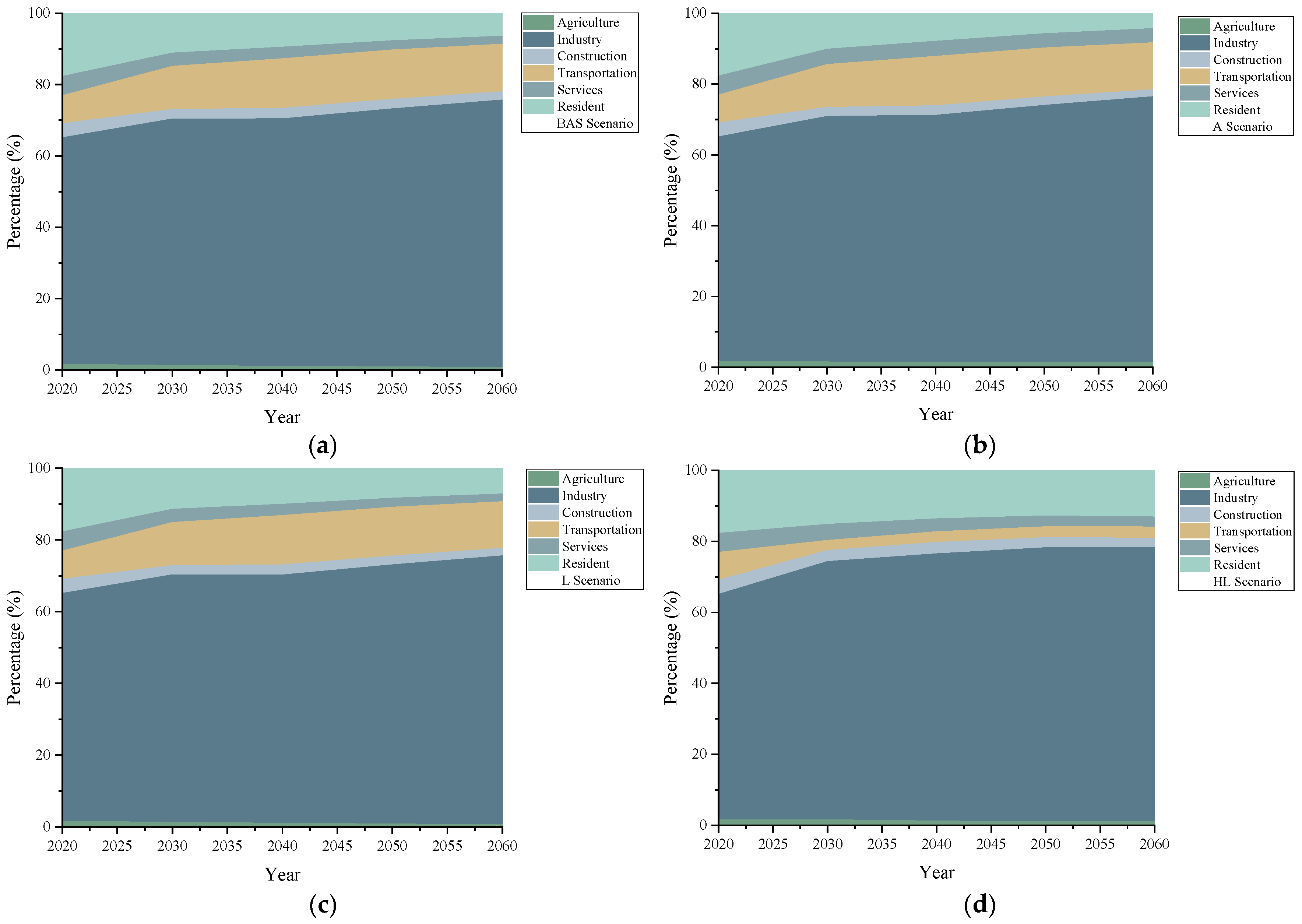
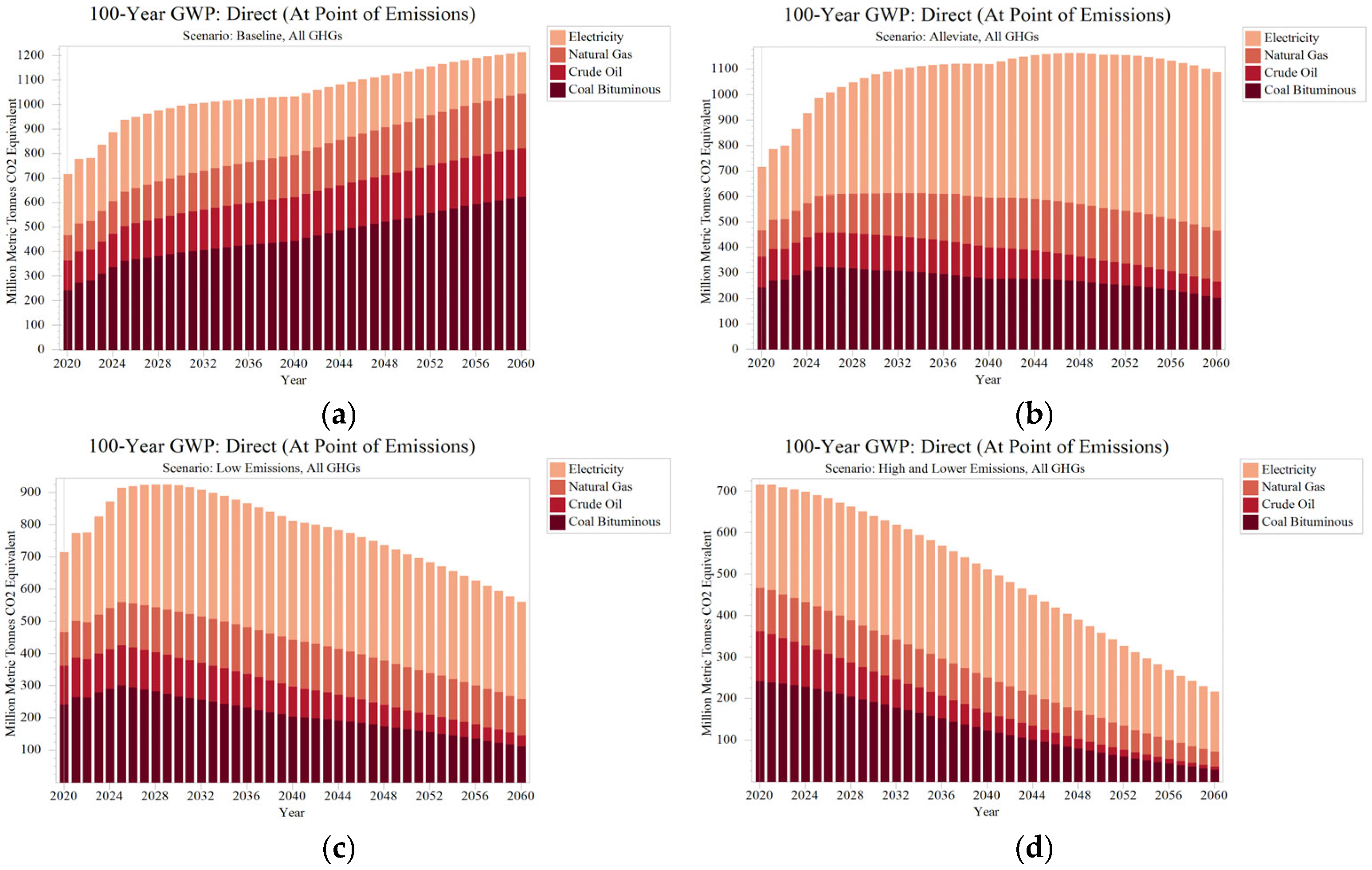
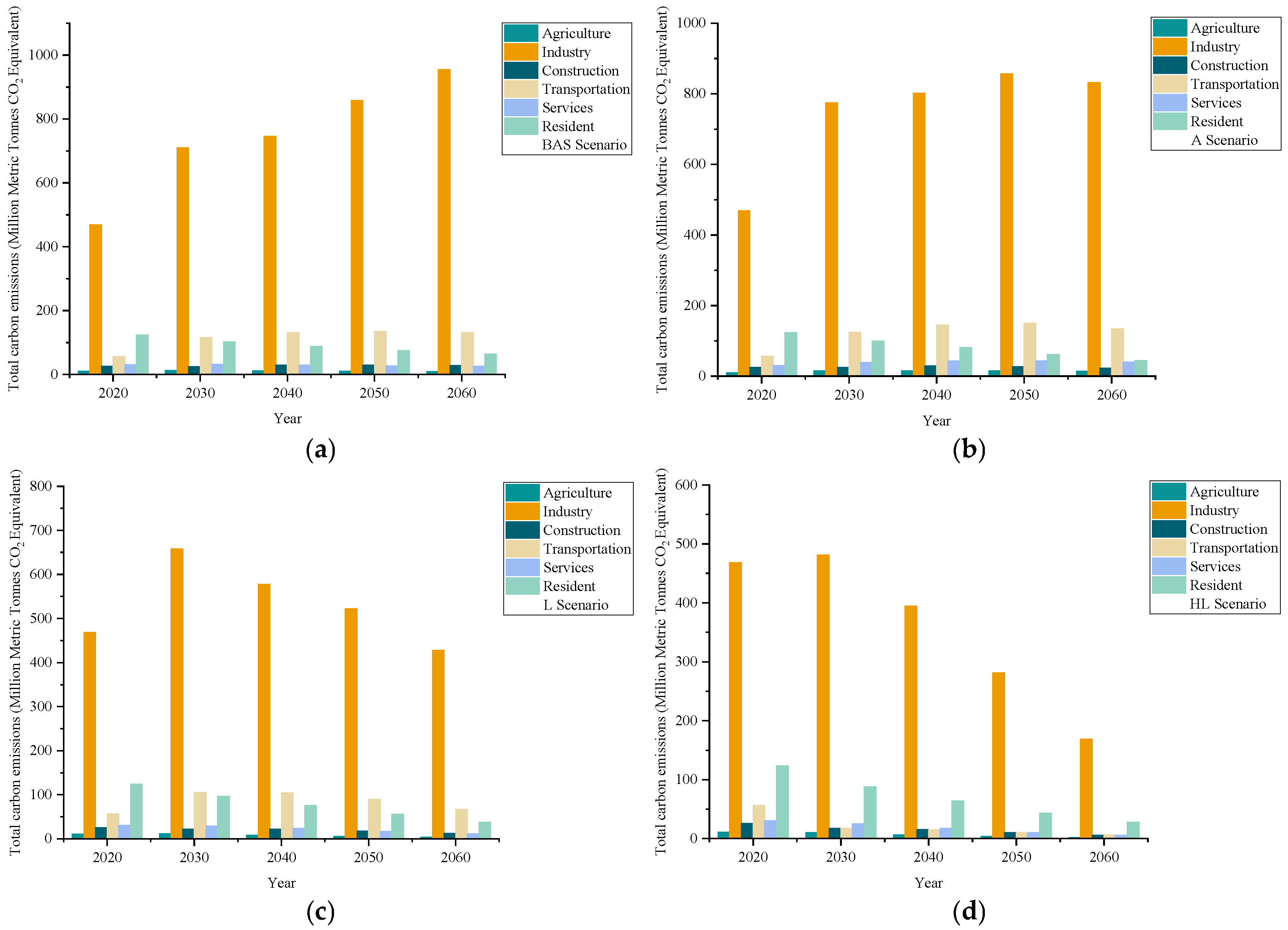
| Region | Agriculture | Industry | Construction | Services | Residents | |
|---|---|---|---|---|---|---|
| Sichuan | Activity Level | 9216.40 | 13,401.02 | 22,572.79 | 16,844.92 | 8371.00 |
| Energy consumption | 369.50 | 12,898.70 | 643.91 | 2094.74 | 3370.40 | |
| Chongqing | Activity Level | 2749.05 | 6990.77 | 14,050.13 | 8464.03 | 3412.71 |
| Energy consumption | 105.50 | 4249.63 | 491.08 | 572.92 | 1411.89 | |
| Total | Activity Level | 11,965.45 | 20,391.79 | 36,622.92 | 25,308.95 | 11,783.71 |
| Energy consumption | 475.00 | 17,148.33 | 1134.99 | 2667.66 | 4782.29 |
| Department | Activity Level | Energy Consumption |
|---|---|---|
| Passenger Transport | 1836.87 | 471.89 |
| Freight transportation | 6258.69 | 1083.98 |
| Car ownership | 2089.47 | 513.62 |
| Scenarios | Category | Changes in Energy Consumption Intensity | Development Situation Assumptions |
|---|---|---|---|
| BAS | Baseline scenario | Reduce | Continuing with the current energy consumption model, fossil energy consumption accounts for a large proportion, and clean energy and electricity are not yet popularized. |
| A | Alleviative scenario | Constant | Coal is gradually withdrawn from various sectors, crude oil demand gradually decreases, and electricity and clean energy consumption increases. |
| L | Low-carbon scenario | Reduce | It is expected that coal will be completely phased out by 2050, and the transportation sector will implement the “oil-to-electricity” approach, which will significantly reduce the demand for crude oil and increase the demand for electricity. |
| HL | High-efficiency low-carbon scenario | Decrease faster | It is planned to significantly phase out coal and oil by 2060; achieve a high level of electrification, with the electrification rate of ordinary industry sectors reaching over 95% and some sectors’ terminal electrification rate exceeding 98%; improve energy efficiency; and gradually reduce power load. |
| Category | Freight Turnover | Passenger Turnover | Car Ownership |
|---|---|---|---|
| Units | 100 Million Ton-Kilometers | 100 Million Passenger Kilometers | 10,000 Vehicles |
| 2020 | 6258.99 | 1836.87 | 2089.47 |
| 2021 | 6782.46 | 1947.87 | 2219.94 |
| 2022 | 6923.99 | 1282.34 | 2349.77 |
| 2030 | 11,169.31 | 11,846.37 | 2812.36 |
| 2040 | 17,787.82 | 17,564.64 | 3735.80 |
| 2050 | 24,790.77 | 24,091.81 | 4032.07 |
| 2060 | 32,178.16 | 31,384.88 | 3222.87 |
| Year | Scenario | Agriculture | Industry | Construction | Transportation | Services | Residents | ||
|---|---|---|---|---|---|---|---|---|---|
| Passenger | Freight | Car Ownership | |||||||
| 2020 | Base Year | 0.03967 | 0.840 | 0.0294 | 0.257 | 0.173 | 0.269 | 0.105 | 0.4058 |
| 2030 | BAS | 0.03083 | 0.752 | 0.0265 | 0.228 | 0.157 | 0.242 | 0.0824 | 0.4046 |
| L | 0.02959 | 0.730 | 0.0253 | 0.222 | 0.153 | 0.236 | 0.0793 | 0.4044 | |
| HL | 0.02778 | 0.710 | 0.0231 | 0.219 | 0.149 | 0.233 | 0.0726 | 0.4042 | |
| 2040 | BAS | 0.02396 | 0.674 | 0.0237 | 0.200 | 0.141 | 0.218 | 0.0657 | 0.4038 |
| L | 0.02207 | 0.653 | 0.0220 | 0.193 | 0.136 | 0.211 | 0.0624 | 0.4034 | |
| HL | 0.01945 | 0.634 | 0.0195 | 0.189 | 0.131 | 0.207 | 0.0546 | 0.4030 | |
| 2050 | BAS | 0.01862 | 0.599 | 0.0211 | 0.174 | 0.126 | 0.200 | 0.0507 | 0.4030 |
| L | 0.01646 | 0.578 | 0.0190 | 0.166 | 0.120 | 0.192 | 0.0470 | 0.4024 | |
| HL | 0.01362 | 0.559 | 0.0163 | 0.161 | 0.115 | 0.188 | 0.0405 | 0.4018 | |
| 2060 | BAS | 0.01447 | 0.527 | 0.0187 | 0.150 | 0.112 | 0.184 | 0.0373 | 0.4022 |
| L | 0.01227 | 0.506 | 0.0163 | 0.142 | 0.105 | 0.176 | 0.0341 | 0.4014 | |
| HL | 0.00954 | 0.487 | 0.0134 | 0.136 | 0.099 | 0.172 | 0.0286 | 0.4005 | |
| Sectors | Fuels | 2020 | 2030 | 2040 | 2050 | 2060 | ||||
|---|---|---|---|---|---|---|---|---|---|---|
| Base Year | A&L | HL | A&L | HL | A&L | HL | A&L | HL | ||
| Passenger | Oil | 38.20 | 31.2 | 28.2 | 23.7 | 16.4 | 15.5 | 5.55 | 7.4 | 3.64 |
| Natural gas | 21.30 | 23.0 | 26.0 | 26.2 | 31.7 | 20.2 | 28.9 | 16.7 | 21.16 | |
| Electricity | 40.50 | 45.8 | 45.8 | 50.1 | 51.9 | 64.3 | 65.5 | 76.0 | 75.21 | |
| Freight | Oil | 19.70 | 15.6 | 15.6 | 12.4 | 9.3 | 8.6 | 5.1 | 5.7 | 4.12 |
| Natural gas | 36.90 | 41.4 | 44.2 | 46.2 | 55.2 | 27.4 | 36.4 | 22.2 | 30.26 | |
| Electricity | 43.40 | 43.0 | 40.2 | 41.5 | 35.6 | 64.0 | 58.6 | 72.2 | 65.62 | |
| Car ownership | Oil | 93.87 | 75.5 | 75.5 | 62.8 | 55.7 | 44.2 | 35.1 | 21.7 | 11.1 |
| Electricity | 6.13 | 24.5 | 24.5 | 37.2 | 44.3 | 55.8 | 64.9 | 78.3 | 88.9 | |
Disclaimer/Publisher’s Note: The statements, opinions and data contained in all publications are solely those of the individual author(s) and contributor(s) and not of MDPI and/or the editor(s). MDPI and/or the editor(s) disclaim responsibility for any injury to people or property resulting from any ideas, methods, instructions or products referred to in the content. |
© 2025 by the authors. Licensee MDPI, Basel, Switzerland. This article is an open access article distributed under the terms and conditions of the Creative Commons Attribution (CC BY) license (https://creativecommons.org/licenses/by/4.0/).
Share and Cite
Xie, X.; Li, Y.; Zhang, H.; Chang, Z.; Zhan, Y. Pathway Simulation and Evaluation of Carbon Neutrality in the Sichuan-Chongqing Region Based on the LEAP Model. Sustainability 2025, 17, 3233. https://doi.org/10.3390/su17073233
Xie X, Li Y, Zhang H, Chang Z, Zhan Y. Pathway Simulation and Evaluation of Carbon Neutrality in the Sichuan-Chongqing Region Based on the LEAP Model. Sustainability. 2025; 17(7):3233. https://doi.org/10.3390/su17073233
Chicago/Turabian StyleXie, Xiaona, Youwei Li, Han Zhang, Zhengwei Chang, and Yu Zhan. 2025. "Pathway Simulation and Evaluation of Carbon Neutrality in the Sichuan-Chongqing Region Based on the LEAP Model" Sustainability 17, no. 7: 3233. https://doi.org/10.3390/su17073233
APA StyleXie, X., Li, Y., Zhang, H., Chang, Z., & Zhan, Y. (2025). Pathway Simulation and Evaluation of Carbon Neutrality in the Sichuan-Chongqing Region Based on the LEAP Model. Sustainability, 17(7), 3233. https://doi.org/10.3390/su17073233







